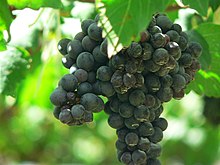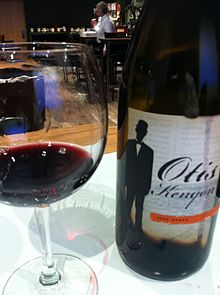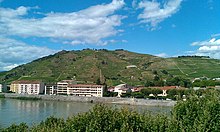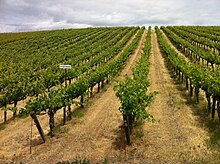Syrah
| Shiraz (Syrah) | |
|---|---|
Hunter Valley, McLaren Vale), New Zealand | |
| Notable wines | Côte-Rôtie, Hermitage |
| Ideal soil | Stony granite |
| VIVC number | 11748 |
| Wine characteristics | |
| General | High tannins, high acidity, blackberry, dark chocolate |
| Medium climate | Mint, eucalyptus, smoked meat, black pepper |
| Hot climate | Liquorice, cloves, espresso, mocha, dark chocolate |
| With age | Leather, wet leaves, earth |
Syrah (
The style and flavor profile of wines made from Syrah are influenced by the
In hot climates (such as
In many regions the
Syrah is used as a single varietal or as a blend. Following several years of strong planting, Syrah was estimated in 2004 to be the world's 7th most grown grape at 142,600 hectares (352,000 acres).[3]
It can be found throughout the globe from France to
It can also be found in several Australian wine regions such as the
History
Origin
Syrah has a long documented history in the Rhône region of southeastern France, but it was not known if it had originated in that region.
A 1998 study conducted by

Dureza, a dark-skinned grape variety from the Ardèche region in France, has all but disappeared from the vineyards, and the preservation of such varieties is a speciality of Montpellier. Mondeuse blanche is a white grape variety cultivated in the Savoy region, and is still found in small amounts in that region's vineyards today.
Both varieties are somewhat obscure today, and have never achieved anything near Syrah's fame or popularity, and there is no record of them ever having been cultivated at long distances from their present homes. Thus, both of Syrah's parents come from a limited area in southeastern France, close to northern Rhône. Based on these findings, the researchers have concluded Syrah originated from northern Rhône.[1][7]
The DNA typing leaves no room for doubt in this matter, and the numerous other hypotheses of the grape's origin which have been forwarded during the years all completely lack support in the form of documentary evidence or ampelographic investigations, be it by methods of classical botany or DNA.
Instead, they seem to have been based primarily or solely on the name or synonyms of the variety. Varying orthography for grape names render dubious any name-based evidence of origins. Nevertheless, origins such as Syracuse or the famous Iranian city of Shiraz have been proposed while the genomic studies had yet to be done.[7]
The parentage information, however, does not reveal how old the grape variety is, i.e., when the pollination of a Mondeuse blanche vine by Dureza took place, leading to the original Syrah seed plant. In the year AD 77,
[8] Pliny called the vines of this wine Allobrogica, and it has been speculated that it could be today's Syrah. However, the description of the wine would also fit, for example, Dureza,[1] and Pliny's observation that vines of Allobrogica were resistant to cold is not entirely consistent with Syrah.[8]
The names Syrah and Shiraz

The grape is called Syrah in its country of origin,
The grape's many other synonyms are used in various parts of the world, including Antourenein noir, Balsamina, Candive, Entournerein, Hignin noir, Marsanne noir, Schiras, Sirac, Syra, Syrac, Serine, and Sereine.[9]
Legends of Syrah's origins often connect it with the city of

The legend connecting Syrah with the city of Shiraz in Iran may, however, be of French origin. James Busby wrote in his Journal of a recent visit to the principal vineyards of Spain and France an excerpt from the 1826 book Œnologie Française; "according to the tradition of the neighbourhood, the plant [Scyras] was originally brought from Shiraz in Persia, by one of the hermits of the mountain" called Gaspare de Stérimberg.[12]
There is a connection between the name Syrah and the word "سیاه" in Persian (pronounced "siah" or "syah," meaning "black"). It refers to the origin of this grape, which comes from black grapes and shows connection between Shiraz in Iran and this grape.[13]
Another legend of the grape variety's origin, based on the name Syrah, is that it was brought from
Another proposed etymology links it with the Proto-Celtic word *serra 'billhook', presumably because the billhook was used in pruning.[14][15][16]
The name "Shiraz" has been used primarily in Australia in modern times. The name "Scyras" was used to describe the grape in the earliest Australian documents, and "Shiraz" has been speculated (among others by Jancis Robinson[9]) to have come about through the "strinization" of the original word, a process of changing vowels as part of Australian slang. However, while the names "Shiraz" and "Hermitage" gradually replaced "Scyras" in Australia from the mid-19th century, the spelling "Shiraz" has also been documented in British sources back to at least the 1830s.[12][17][18] So while the name or spelling "Shiraz" may be an effect of the English language on a French name, there is no evidence that it actually originated in Australia, although it was definitely the Australian usage and the Australian wines that made the use of this name popular.
Rise to fame
The wines that made Syrah famous were those from Hermitage, the hill above the town
In the 18th and the first half of the 19th centuries, most Hermitage wine that left France did so as a blending component in Bordeaux wines. In an era when "
Arrival in Australia
In 1831, the Scotsman
Modern history
Syrah continues to be the main grape of the northern Rhône and is associated with classic wines such as
From the 1970s and even more from the 1990s, Syrah has enjoyed increased popularity, and plantings of the variety have expanded significantly in both old and new locations.[7] In the early 2000s, it broke into the top 10 of varieties planted worldwide for the first time.[3]
Shiraz wines

The name "Shiraz", from Shiraz in Iran, was historically applied to a wine unrelated to contemporary Shiraz wines and was made from a grape or grapes entirely different from the Syrah that has been proven to originate in southeastern France.[23]
Smaller amounts of Syrah are also used in the production of other wine styles, such as
Due to their concentrated flavours and high
Syrah has one of the highest recommended
Taste and flavours
Wines made from Syrah are often powerfully flavoured and full-bodied. The variety produces wines with a wide range of flavor notes, depending on the climate and soils where it is grown, as well as other
C13-
Syrah or Shiraz on labels

The Syrah-dominated appellations (AOCs) of northern Rhône have, like most other French appellations and regions, no tradition of varietal labeling of their wines. Indeed, such practices are generally disallowed under AOC rules, and only the AOC name (such as Cote-Rotie, Crozes-Hermitage or Hermitage) appears on the label. Varietal labeling of Syrah/Shiraz wines is therefore a practice that has emerged in the New World, primarily in Australia.
To confuse matters, in northern Rhône, different clones of genuine Syrah are referred to as Petite Syrah (small Syrah) or Gros Syrah (large Syrah) depending on the size of their berries, with Petite Syrah being considered the superior version, giving wines higher in
As a general rule, most Australian and South African wines are labeled "Shiraz", and most European wines (from such regions where varietal labeling is practiced) are labeled "Syrah". In other countries, practices vary and winemakers (or wine marketers) sometimes choose either "Syrah" or "Shiraz" to signify a stylistic difference in the wine they have made. "Syrah"-labelled wines are sometimes thought to be more similar to classic Northern Rhône reds; presumably more elegant, tannic, smoke-flavoured and restrained with respect to their fruit component. "Shiraz"-labelled wines, on the other hand, would then be more similar to archetypical Australian or other New World examples, presumably made from
Syrah in different countries
Syrah is a variety that during the last few decades has been imported for cultivation in several countries. It is primarily grown in warmer regions. Worldwide plantations of Syrah have increased considerably in the late 1990s and early 2000s, and both "Syrah"-labelled and "Shiraz"-labelled wines are on the increase.[7]
It is grown in many wine producing regions around the world, with concentrations in Australia, The Rhone Valley in France, and the US. It is often used as a blending grape in Spain and Italy as well. It is also planted in Portugal, which favor making varietal Syrah wine, and not only blending with other types.
Italy
In Italy, Syrah is grown in
France

Syrah, as it is known in France, is grown throughout the
Syrah is also a key component to many blends. It may be used to add structure and color to
In 1968, there existed only 2,700 hectares (6,700 acres) of Syrah vineyards in France, primarily in the traditional appellations of northern Rhône, which at that time had not received much attention in the wine world for several decades, and the vineyards of which were not planted to full capacity. After the wines of northern Rhône were "rediscovered" by wine writers in the 1970s, plantings expanded considerably. This trend received an extra boost in the 1980s and 1990s, when influential wine writer
While previously unused parts of the northern Rhône vineyards have been planted with Syrah as part of the expansion, the major part of the new French Syrah plantations are located in southern Rhône (which covers a much larger vineyard area than the northern part) and Languedoc-Roussillon.[7] While southern Rhône produces relatively few wines where Syrah is in the majority, the proportion of Syrah in the blended wines of this region has been on the rise. Languedoc-Roussillon uses Syrah to produce both Southern Rhône-like blends with Grenache, Australian-style blends with Cabernet Sauvignon, and varietal Syrah.
Syrah vines in France often suffer from a form of dieback characterised by the leaves turning red in late summer, deep cracks developing in the stem above the
Spain
In Spain there was an increase in the area cultivated in Syrah grapes from 4,000 hectares (9,900 acres) in 1990 to 19,045 hectares (47,060 acres) in 2009.. As of 2015 it was the seventh most grown red grape in Spain, with 20,155 hectares (49,800 acres) accounting for 4% of the red grape total.
Switzerland
The Syrah grape was introduced into Switzerland in 1926 and in 2009 was the 6th most common red wine grape in Switzerland (181 hectares).[34] Mostly grown in Valais, along the upper Rhône valley above Lake Geneva, it produces "unexpectedly concentrated wine from mature vines".[34]
Argentina
Syrah plantations in Argentina increased from less than 1,000 hectares (2,500 acres) in 1990 to 9,500 hectares (23,000 acres) in 2002.[7] Syrah has occasionally been used as a blending component with Argentina's signature dark-skinned grape Malbec to provide an "Argentinian take" on the Australian Cabernet-Shiraz blend.
Australia
The Syrah grape was introduced into Australia in 1832 by James Busby, an immigrant who brought vine clippings from Europe with him, and it is almost invariably called "Shiraz".[6] Today it is Australia's most popular red grape, but has not always been in such favour; in the 1970s, white wine was so popular that growers were ripping out unprofitable Shiraz and Grenache vineyards, even those with old vines. In the Barossa Valley, the world's oldest continually producing commercial vineyard is believed to be the Shiraz vines at Turkey Flat in Tanunda that were originally planted in 1847.[35]
Many factors, including the success of brands like Lindemans (part of
In the 2005–2006 growing season, total Shiraz plantations in Australia stood at 41,115 hectares (101,600 acres), of which 39,087 hectares (96,590 acres) were old enough to be productive. These vines yielded a total of 422,430 tonnes of Shiraz grapes for wine production. This made Shiraz the most planted variety in Australia[37] and Australia the world's second largest Syrah/Shiraz grower, after France.[7]
Victorian regions include Heathcote, roughly 1.5 hours north of Melbourne. Cooler climate regions such as Western Australia's Margaret River produce Shiraz with marginally less alcohol content and often in a more traditional French style.
A well-known example of the Shiraz grape in Australian viticulture is the Penfolds "Grange". This wine was created by winemaker Max Schubert in 1951 and has a reputation for aging well. The Penfolds Grange is predominantly Shiraz but often includes a small quantity of Cabernet Sauvignon. It is usually a multi-regional blend of quality South Australian Shiraz, with the Barossa Valley playing an important role, and matured in new American Oak. Other well-known Australian Shiraz wines include the Henschke "Hill of Grace" and the Penfolds "RWT".
Recently, Australian Shiraz producers have started to add up to 4% Viognier to their Shiraz to add apricot tones to the wine's nose and palate. With such a small percentage added, the producer wasn't obliged to declare the blend on the label. In the past 5 years, however, it's becoming increasingly fashionable to label the wine "Shiraz Viognier" as Viognier gains consumer acceptance in the marketplace. The practise of blending Viognier with Syrah has actually been common for years in the Northern Rhône Valley region of Cote-Rotie.[38]
"Shiraz" is also the S in "GSM" (Grenache-Shiraz-Mourvèdre), which is common Australian designation for a Châteneuf-du-Pape-like blend.
South Africa
South African plantations have expanded significantly, from 1% of the vineyard area in 1995 to 9.7% in 2007[39] making up a total area under cultivation of 9,856 hectares (24,350 acres). In South Africa, the variety is predominately known as "Shiraz", but the designation "Syrah" is used for "Rhône-style" wines.[10] Some see this variety as the "great hope" for South African wines.[40]
United States

In the United States, wine produced from the grape is normally called by its French name, "Syrah". However, in cases where winemakers choose to follow a New World style, similar to

California Syrahs, much like those in France, vary a great deal based on the climate and
Chile
Around 2005, there were 2,500 hectares (6,200 acres) of Syrah in Chile.[7]
Durif
Durif, or Petite Sirah, is a descendant of Syrah and Peloursin. It was propagated by and named after Dr. Francois Durif. Durif is a cross breed between the lesser known Peloursin and Syrah. Regions such as Rutherglen have achieved international regard for their Durif. This varietal is similar to Shiraz but is even more full-bodied and tannic because of the smaller, thicker-skinned grapes used. Petite Sirah is widely planted in California, where it is popular as a varietal (for example, by Bogle Vineyards), and especially blended with Zinfandel, which results in a rich, bold and fruity wine.
Synonyms
Synonyms for Syrah include Antourenein noir, Candive, Entournerein, Hermitage, Hignin noir, Marsanne noir, Shiraz, Sira, Sirac, Sirah, Syra, and Syrac.[34]
See also
References
- ^ a b c d "Syrah WORLDWIDE ROMA" (PDF). Archived from the original (PDF) on 2012-01-08.
- ^ ISBN 9781905819157.
- ^ ISBN 0-19-860990-6.
- doi:10.17660/ActaHortic.2000.528.15. Proceedings of the Seventh International Symposium on Grapevine Genetics and Breeding. Archived from the originalon 2018-06-01. Retrieved 2008-02-15.
- ^ Vouillamoz, J.F. and Grando, M.S. 2006. "Genealogy of wine grape cultivars: 'Pinot' is related to 'Syrah'", Heredity 97:102–110 Quote: "Our data strongly confirmed the 'Syrah' parentage ('Dureza' x 'Mondeuse blanche') established by Bowers et al."
- ^ ISBN 978-0-15-100714-1.
- ^ ISBN 0-19-860990-6.
- ^ ISBN 0-19-860990-6.
- ^ ISBN 978-1-85732-999-5.
- ^ ISBN 0-19-860990-6.
- ISBN 0-19-860990-6.
- ^ a b Busby, James (1834). Journal of a recent visit to the principal vineyards of Spain and France. Smith, Elder. p. 108.
1826 scyras shiraz.
- ISBN 1-84000-972-1.
- ^ "The Old North". www.old-north.co.uk.
- ^ "NAMES - The Name Syrah : popularity, meaning and origin, popular baby names". Popular-BabyNames.com.
- ISBN 9789004173361– via Google Books.
- ^ Redding, Cyrus (July 1834). "History of Wines". Gentleman's Magazine. 157: 7–11.
- ^ Redding, Cyrus (1836). A history and description of modern wines. Whittaker & co. p. 20.
- ISBN 0-19-860990-6.
- ISBN 0-19-860990-6.
- ISBN 0-19-860990-6.
- ^ "James Halliday: Syrah in Australia since 1800, pp. 10-14 in: The Syrah Producers' Club 19 April 2004 – Syrah Worldwide Roma" (PDF). Archived from the original (PDF) on May 12, 2006.
- ISBN 0-19-860990-6.
- ISBN 978-1-56305-434-1.
- ^ W. Blake Gray (2005-05-26). "RED FIZZ Australian-style red bubbly is a grown-up pleasure". San Francisco Chronicle. Retrieved 2006-10-14.
- ^ Bonné, Jon, msnbc.com (September 21, 2005). The perfect temperature for wine.
- ISBN 978-0-8412-3729-2.
- ^ ISBN 978-0-15-100714-1.
- ^ ISBN 978-0-7892-0883-5.
- ISBN 978-0-19-860990-2.
- ^ "Dépérissement de la Syrah" (in French). Institut Français de la Vigne et du Vin. Archived from the original on 8 August 2014. Retrieved 4 August 2014.
- ^ "Brochures techniques: Dépérissement de la Syrah" (in French). Institut Français de la Vigne et du Vin. Archived from the original on 23 April 2009. Retrieved 4 August 2014.
- ^ "Catálogo general de las variedades y los clones de uva de vino y de mesa" (PDF). Agromillora (in Spanish). Vivai Cooperativi Rauscedo. 2013. p. 101. Archived from the original (PDF) on 24 April 2016. Retrieved 15 May 2018.
- ^ ISBN 978-1-846-14446-2.
- ISBN 0307346358.
- ISBN 9781925261097. Retrieved 15 May 2018.
- ^ Australian Wine and Brandy Corporation: Areas of vines and grape production by variety – 2005-06 Archived 2008-07-22 at the Wayback Machine, accessed on March 17, 2008.
- ^ Jancis Robinson (2005-10-15). "Viognier – it's everywhere nowadays". Archived from the original on 2006-04-07. Retrieved 2006-12-20.
- ^ "South African Wine Industry Statistics 2008" (PDF). Archived (PDF) from the original on 2022-10-09.
- ^ Platter's South African Wines 2009, p66
- ISBN 978-0-15-100714-1.
- ISBN 0-520-24869-4.
- ISBN 978-0-15-100714-1.
